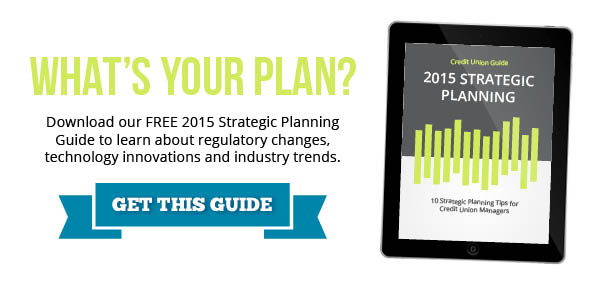They say that those who fail to plan are planning to fail. While it would be a rare organization that does NO planning, too often we fall into one of two camps:
- Planning for the near term, being essentially ‘reactive’ to current conditions
- Writing a strategic plan and then putting the plan on the shelf and never enacting its provisions
 We’d like to suggest a third, and better camp. The proactive, mid-to-long-range strategic planning camp.
We’d like to suggest a third, and better camp. The proactive, mid-to-long-range strategic planning camp.
Why do boards find strategic planning so hard? It’s probably because they feel they can’t predict the future and therefore find it difficult to plan for the unknown. True, we cannot know the future. But credit union boards are composed of passionate, resourceful people. They CAN create scenarios. They CAN conceptualize the credit union’s future and plan to make it happen.
Strategic planning requires a deep and strong commitment from the credit union’s leadership – it seeks ownership at every level of the organization. So WHY do it? Here’s some of the most important reasons:
- To clarify the mission to all stakeholders
- To assess, reassess, and adjust programs and services
- To reaffirm that the credit union is headed where it wants to go or should be going
- To focus thinking "outside the box" of everyday operations
- To develop a framework within which to make difficult decisions
- To address external uncertainties and change
- To build teamwork, communication and expertise among board and staff
- To measure organizational effectiveness by incorporating evaluation or measurements into the process
But who’s responsible for strategic planning? Let’s take a look at the roles in strategic planning:
Role of the Board
Without the full board’s blessing and participation, the success of the planning effort is compromised. Whether the board or the CEO introduces the need for planning, the board must be behind the decision to move forward, and then ultimately approve the final directives. The board’s role is to set direction and, with the CEO, determine and fine-tune the mission, vision, and the values of the credit union.
Role of the CEO
The CEO is in the in the driver’s seat, taking charge and managing the strategic planning process. They often are the visionary, hoping to articulate the options available for the future and then get the board’s blessing. They usually are the instigator of the planning idea and sees that the plan is executed in a concrete manner. They coordinate the participation of everyone whose collaboration is needed. They may delegate some of the individual tasks to others but they remain the supervisor who ensures that planning proceeds as expected.
Role of the Staff
Without the staff’s input, perspective, support during planning, and final implementation of the plan it would be impossible to carry out the strategic planning process from conception to successful results. After the overall plan is defined by the board and management, the staff should be busy drafting their own operational plans for implementation. The operational plans are the natural next step to the strategic plan. They translate the board-approved objectives into workable actions and schedules.
Role of a Consultant
A consultant or professional facilitator can add objectivity and autonomy to the process while also alleviating the stress of the additional work load. A facilitator can ensure that all the steps to strategic planning receive proper attention. A consultant acts as a mere facilitator who directs the process and runs the meetings but does not impose his or her opinions. They may also act as the professional guide who takes the responsibility of defining the key issues through interviews and other methods, and then helps steer the board and staff in the right direction.
As the world of credit unions becomes more and more complex with never-ending regulatory changes, interest rate risk, cybersecurity threats, the upcoming EMV chip card technology, mobile banking and payments, and declining non-interest income the importance of strategic planning has never been stronger.
By Karen Houston-Johnson, VP, Credit Union Resources, Inc.
%20formatted-1.png?width=2528&height=739&name=SIGNiX%20Logo%20Main%20(white)%20formatted-1.png)

